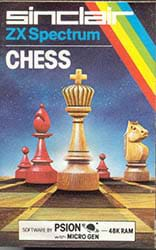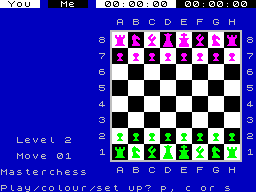
- Catalogue No :
- Original Price : £5.95
- Developer : Psion
- Computer : ZX Spectrum
- Number Of Players : 1
- Genre : Board Game
- Keyboard Controls : Yes
- Joystick Control : No
Sinclair ZX Spectrum Chess
A chess program for the Sinclair Spectrum with 48K RAM written in fast and efficient machine code.The chessboard and chess pieces are displayed in high resolution garphics.Ten levels of Spectrum ability: level 2 will probably beat you!
Load A Program
The procedure for loading a program is described in chapter 20 of the Spectrum manual.The steps are summarised below.
- 1.Connect the ear socket on your Spectrum to the ear socket on your cassette recorder.
- 2.Position the tape before the beginning of the program that you wish to load.
- 3.Turn the volume control to 3 / 4 of maximum or to a level which you have found to be reliable on your recorder.
- 4.Type LOAD "PROGRAM NAME" and press ENTER.The program name is printed on the cassette.
- 5.Start the cassette recorder playing.
- 6.Press any key.
PSION cassettes for the Sinclair ZX Spectrum are designed to load over a very wide range of volume and tone settings on your tape recorder.If you have any difficulty, ensure that the head and pinch roller of your tape recorder are quite clean.Cleaning kits for this purpose are widely available.
(c) Copyright 1982 Psion Ltd.
Sinclair ZX Spectrum with 48K RAM Chess from Psion with Micro Gen
CHESS is a machine code program which automatically starts executing once it has loaded.
Load and run by typing LOAD "CHESS"
After loading the chessboard with pieces laid out for the beginning of a game will automatically appear.
The program will ask the user whether he wants to play or set up the board differently.Press P to play.The user will then be asked what colour he would like to play.Press W for white and B for black.Finally the level of play is required.Press a number from 0 to 9.Usually it is sufficient to play at one of the lower levels(0 to 3, say) for a rapid response to moves. The positions of the pieces on the board are defined by using the modern algebraic notation. The columns on the board are labelled A to H and the rows 1 to 8.
White Queen's rook is always the square A1 in the initial set-up. The rows and columns on the board are labelled on the screen.
To enter your move, type the coordinates (column letter followed by row number) of the square of the piece you want to move followed by the coordinates of the square to which you wish to move it. No delimiter between the coordinates "from" and "to" is required - it will automatically be inserted. After you have typed in your move, the appropriate piece will be moved, and the computer will consider and apply its move.
All legal moves are allowed including castling and en passant. The program will not allow an invalid move on the part of the user. Castling is achieved by entering the king's move. On entering your move, if you make an error, you may always correct it by using the delete key either shifted or unshifted.
A number of commands may be applied at any stage. Typing the key R asks the computer to recommend a move to you and it will do so at the same level of search on which it is currently set.L allows you to change the level at which the computer is playing.Z will copy the complete screen to an attached printer.T will save the current game to cassette to enable it to be resumed later.X exits from the game to start afresh or to set up the board.
Setting up the board
You may set up the board to examine a problem as you wish.At the start of the game or after exiting, press S for set - up.The cursor keys 5, 6, 7, and 8 can be used either shifted or unshifted to move a flashing cursor around the screen.The command C clears the board of pieces completely.The delete key deletes the piece at the cursor position.The letters K, Q, R, B, N and P are used to place the appropriate piece on the board.X exits from the set-up routine.
